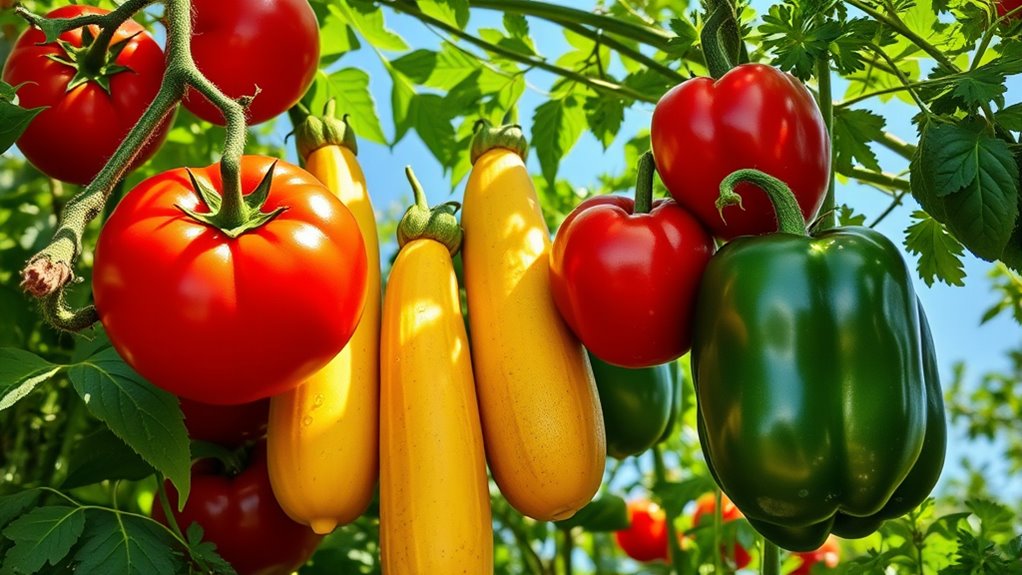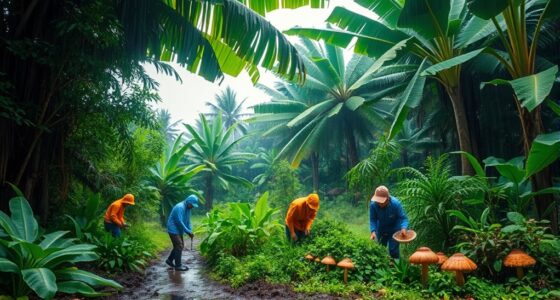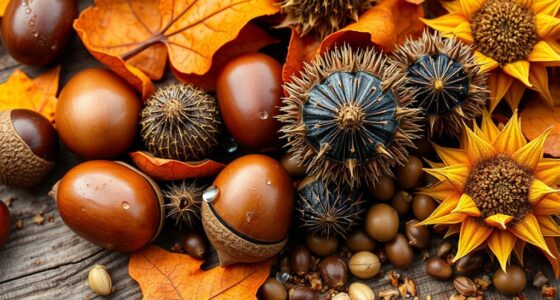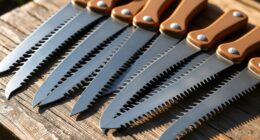In July, focus on harvesting high-yield vegetables like zucchini, peppers, and beans, which thrive in warm weather. Enjoy summer berries such as strawberries and blackberries, along with tropical fruits like mangoes and pineapples if they’re in season. Grow herbs like basil, mint, and cilantro for continuous supply. To boost your harvest, apply soil enrichment, consistent watering, mulching, and natural pest control. Want to maximize your bounty? Keep exploring for expert tips and tricks.
Key Takeaways
- Focus on harvesting high-yield vegetables like zucchini, peppers, and beans, which thrive in July’s warm weather.
- Cultivate summer berries (strawberries, blueberries) and tropical fruits (mangoes, pineapples) during peak July ripeness.
- Use soil enrichment, deep watering, and mulching to promote healthy growth and maximize yields.
- Implement natural pest control and companion planting to protect plants and improve productivity.
- Preserve surplus produce through canning, freezing, or dehydrating to enjoy the bounty year-round.
Best Vegetables for a July Harvest
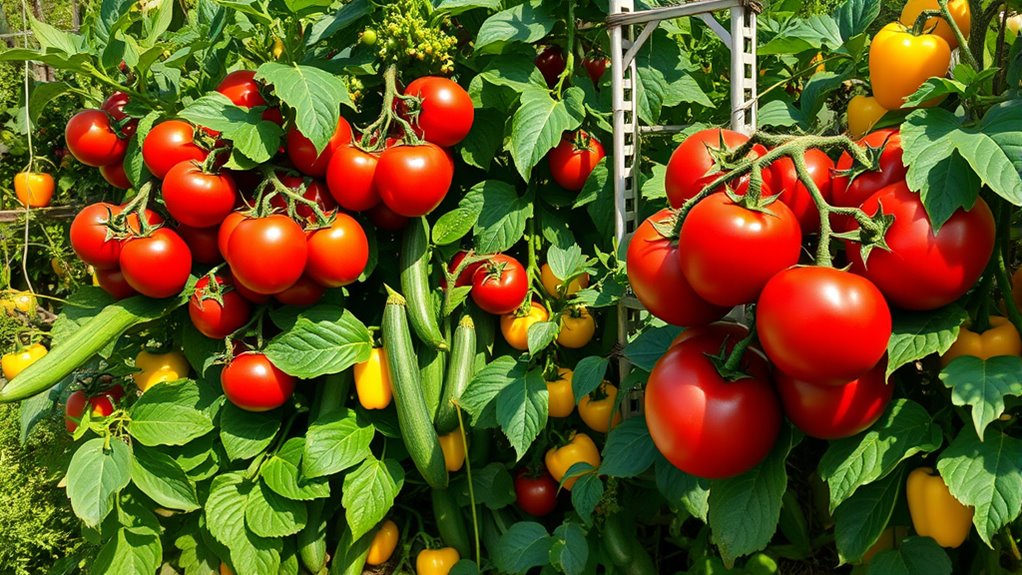
As July rolls in, many vegetables reach their peak of freshness and flavor, making it an ideal time to harvest your garden. To maximize your yield, consider using companion planting strategies that boost growth and protect plants naturally. For example, planting tomatoes near basil not only enhances flavor but also helps repel pests. Additionally, focus on soil improvement by rotating crops and adding compost, which enriches nutrients and promotes healthy root development. This approach guarantees your vegetables like zucchini, peppers, and beans thrive during peak season. Healthy soil combined with smart companion planting creates a thriving environment that yields abundant, flavorful vegetables. Incorporating soil health practices can further enhance your garden’s productivity and resilience throughout the summer.
Top Herbs to Grow for Summer Abundance
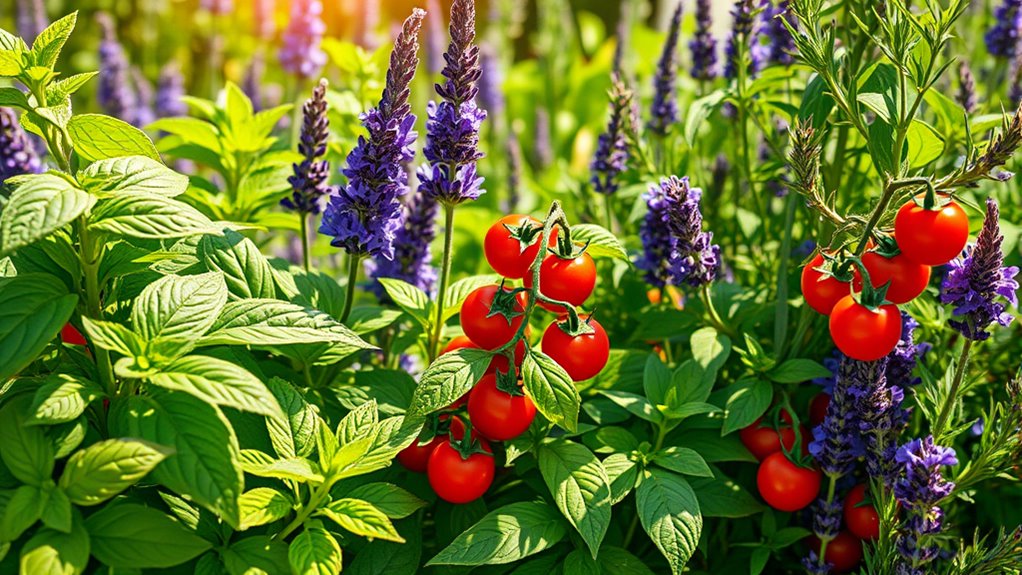
Growing herbs alongside your vegetables not only enhances your garden’s flavor profile but also guarantees a continuous supply of fresh, aromatic greens throughout summer. Basil, mint, and cilantro are top choices for abundant harvests. These herbs grow quickly and can be regularly harvested to encourage new growth. To preserve their flavor, consider herb drying, which allows you to enjoy fresh herbs year-round. Keep pests at bay with natural pest management techniques like companion planting or organic sprays, ensuring your herbs stay healthy and productive. Regular harvesting also helps prevent pest infestations and keeps plants vigorous. Ensuring proper installation and venting of your herb garden can improve air circulation and plant health. By growing these herbs, you’ll add vibrant flavors to your meals while maintaining a lush, pest-free garden. Plus, dried herbs from your summer harvest will be a flavorful treasure for months to come.
Fruit Plants That Thrive in July
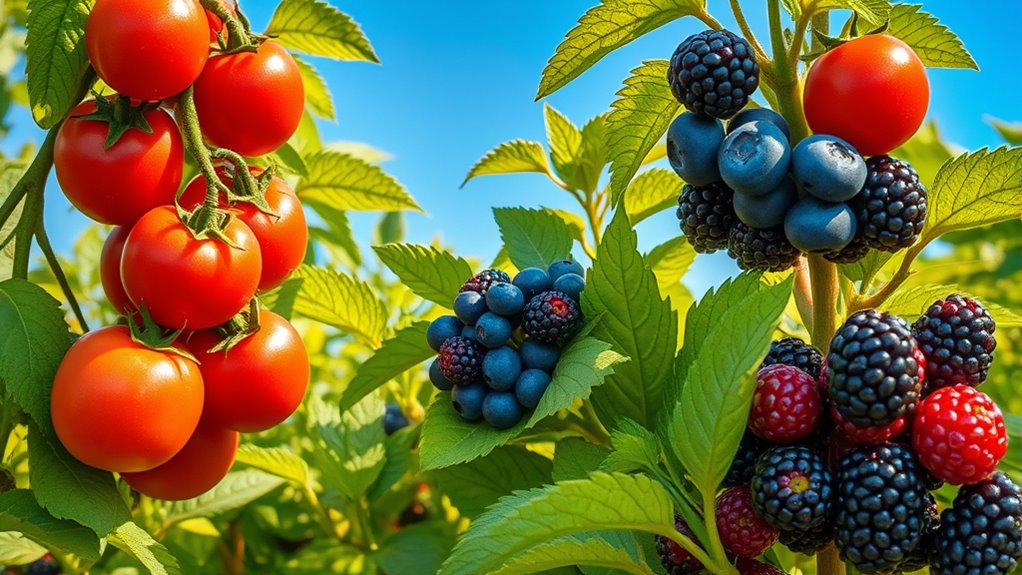
In July, you can enjoy a variety of summer fruits that flourish in warm weather, like berries and stone fruits. Knowing the best time to harvest guarantees you get peak flavor and freshness from your plants. Let’s explore which fruit varieties thrive now and when to pick them for the best results. To ensure optimal taste, it’s helpful to understand the timing of harvest for different fruits.
Summer Fruit Varieties
Have you ever wondered which fruits flourish during the peak heat of July? This is the perfect time to enjoy vibrant tropical fruit varieties like mangoes, papayas, and pineapples, which thrive in warm weather. These fruits not only add sweetness to your summer but also boost your nutrition. Additionally, summer berry options such as strawberries, blueberries, and blackberries reach their peak, offering fresh, juicy flavors straight from your garden or local market. Many of these berries are hardy and produce abundant yields during July, making them ideal for snacking or baking. The right tuning techniques can also help optimize your gardening tools and equipment for easier harvests. By planting or harvesting these summer fruit varieties now, you’ll enjoy the best flavors and highest yields, adding a burst of color and taste to your summer days.
Optimal Harvest Timing
To maximize your harvest this July, focus on timing the peak ripeness of fruit plants that thrive during this month. Knowing the ideal timing for perennials is essential, as fruit like blueberries and raspberries reach prime ripeness now. Regularly check your plants for signs of readiness, such as color change and firmness. Adjusting harvest schedules based on these cues ensures you pick fruits at their best flavor and nutrition. Keep in mind that overripe fruits can quickly spoil, so harvest promptly once they’re ripe. Staying attentive to the timing for perennials helps you enhance yield and quality. Additionally, observing local water park traffic and seasonal patterns can provide insights into the best times for outdoor activities, including harvesting in nearby gardens. By carefully planning your harvest, you’ll enjoy the freshest, most flavorful fruits during this abundant July.
Maximizing Your Garden’s Yield: Tips and Tricks
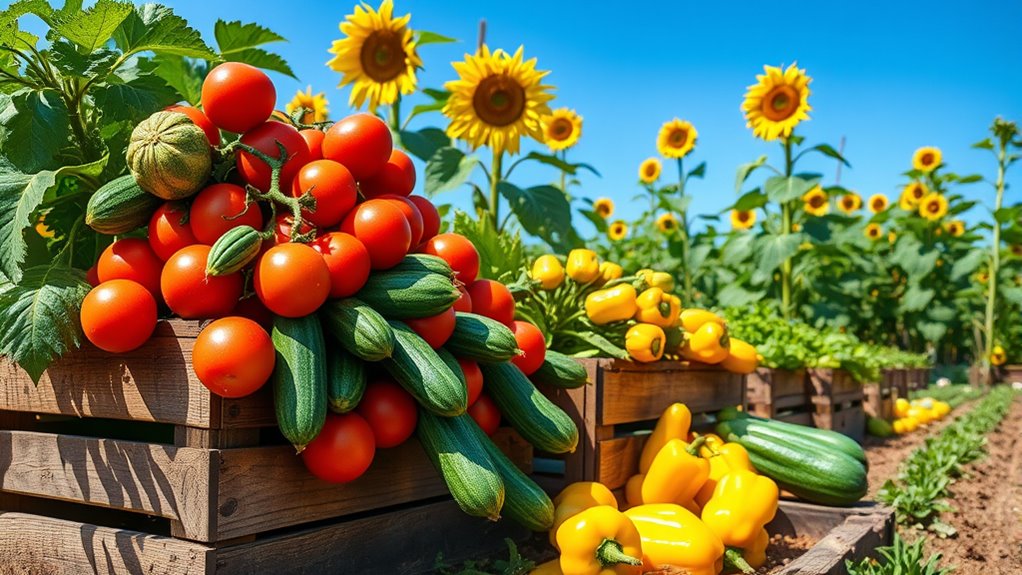
Maximizing your garden’s yield requires strategic planning and attentive care. Start by enriching your soil with appropriate soil amendments to boost fertility and improve plant health. Well-balanced compost or organic matter can provide essential nutrients, encouraging robust growth and higher yields. Additionally, effective pest management is vital to protect your plants from pests and diseases that can reduce productivity. Regularly inspect your garden for signs of trouble and use natural or organic pest control methods to keep pests at bay without harming beneficial insects. Proper watering, staking tall plants, and pruning can also prevent stress and promote better airflow, reducing disease risk. Incorporating high-yield plants into your garden selection can significantly enhance your harvest. By combining soil improvements with vigilant pest management, you set the foundation for a thriving, high-yield garden this summer.
Companion Planting for Higher Productivity
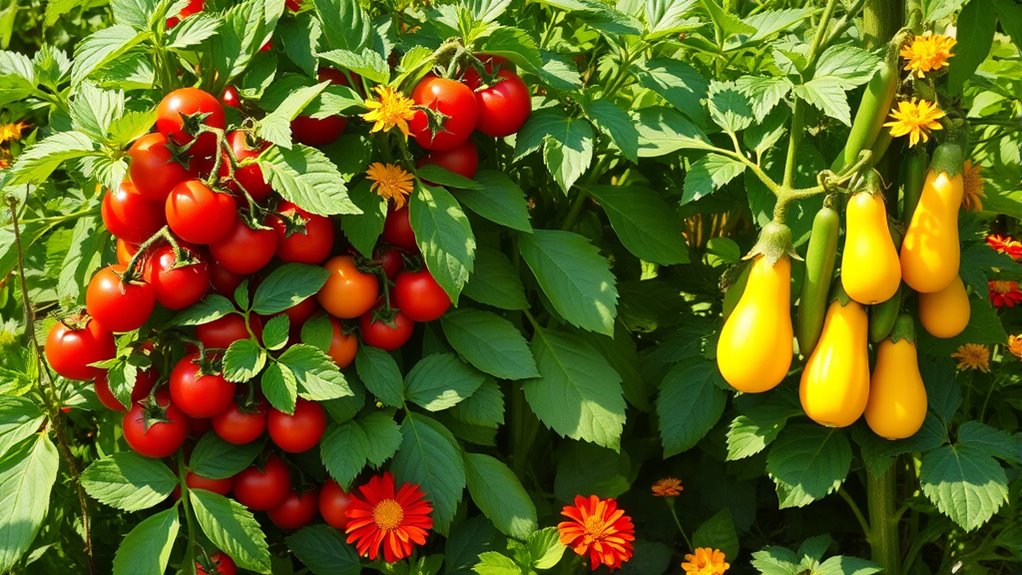
Did you know that planting certain crops together can greatly boost your garden’s productivity? Companion planting improves pest management and enhances soil health through natural interactions. For example, basil deters pests from tomatoes, while marigolds repel nematodes. Use soil amendments like compost to strengthen plant growth. Additionally, incorporating renewable energy concepts such as solar-powered garden lighting can make your gardening more sustainable. Here’s a helpful guide:
| Crop Pair | Benefits | Notes |
|---|---|---|
| Tomatoes & Basil | Pest control, flavor boost | Basil repels flies |
| Carrots & Onions | Pest deterrent | Improve soil with amendments |
| Lettuce & Radishes | Faster growth, pest management | Radishes break soil |
| Beans & Corn | Nitrogen fixation, support | Beans fix nutrients in soil |
Strategic pairings promote higher yields naturally, reducing pest issues and improving soil quality.
Watering and Care Strategies During Hot Months
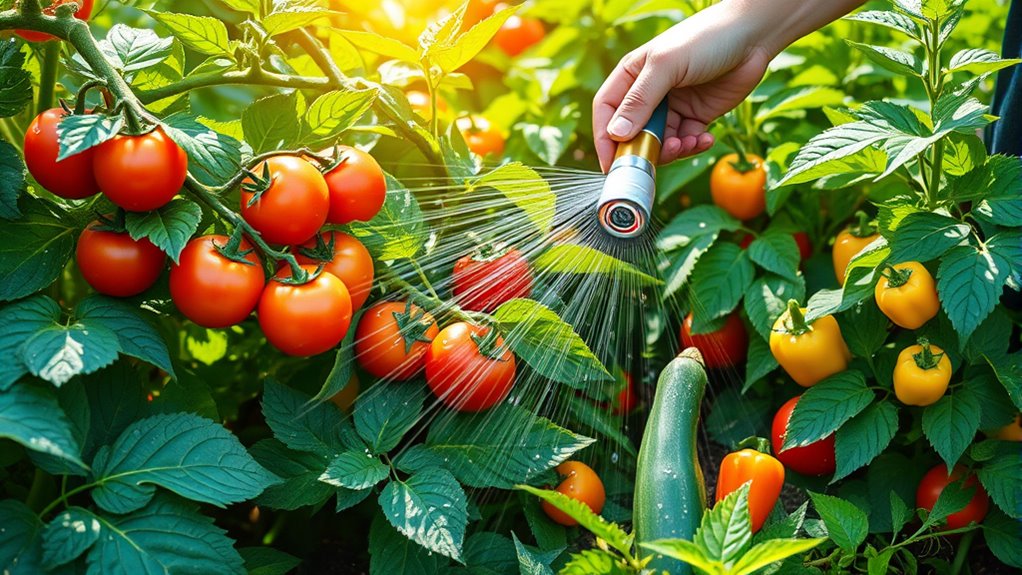
During hot months, deep watering guarantees your plants receive enough moisture to withstand the heat. Applying mulch around your plants helps retain that moisture and keeps the soil cooler. Together, these strategies keep your garden healthy and productive despite the scorching weather. Monitoring plant symptoms can help you detect early signs of stress or disease caused by the heat.
Deep Watering Techniques
When the heat rises, deep watering becomes essential to keep your plants healthy and resilient. It guarantees the soil moisture reaches roots deep below the surface, promoting strong growth and drought resistance. To do this effectively, stick to a consistent watering schedule that allows the soil to dry slightly between sessions. Deep watering encourages roots to grow downward, making plants better equipped to handle hot weather. Use a slow, steady stream of water to penetrate at least 6-8 inches into the soil. Avoid shallow watering, which only wets the surface and encourages shallow roots. Monitor soil moisture regularly. If the top few inches are dry, it’s time to water deeply. Proper deep watering can notably improve plant health during scorching summer months. Incorporating project management support can help ensure your watering routine aligns with your overall garden maintenance plan.
Mulch to Retain Moisture
After establishing deep watering routines, applying mulch around your plants helps lock in moisture and regulate soil temperature. Mulch acts as a barrier, reducing evaporation and keeping roots cool during hot months. It also enhances soil enrichment by breaking down gradually, adding organic matter that boosts plant health. Additionally, mulch helps with pest control by creating a physical barrier that deters certain pests from reaching your plants. Make sure to spread a 2-3 inch layer of mulch around your garden beds, keeping it a few inches away from plant stems to prevent rot. Regularly replenishing mulch ensures it maintains its moisture-retaining and soil-improving benefits. Practicing vertical storage solutions can help organize gardening tools and supplies, making your gardening routine more efficient. This simple step supports high yields by maintaining ideal growing conditions and reducing the need for frequent watering.
Extending Your Harvest: Preservation and Storage
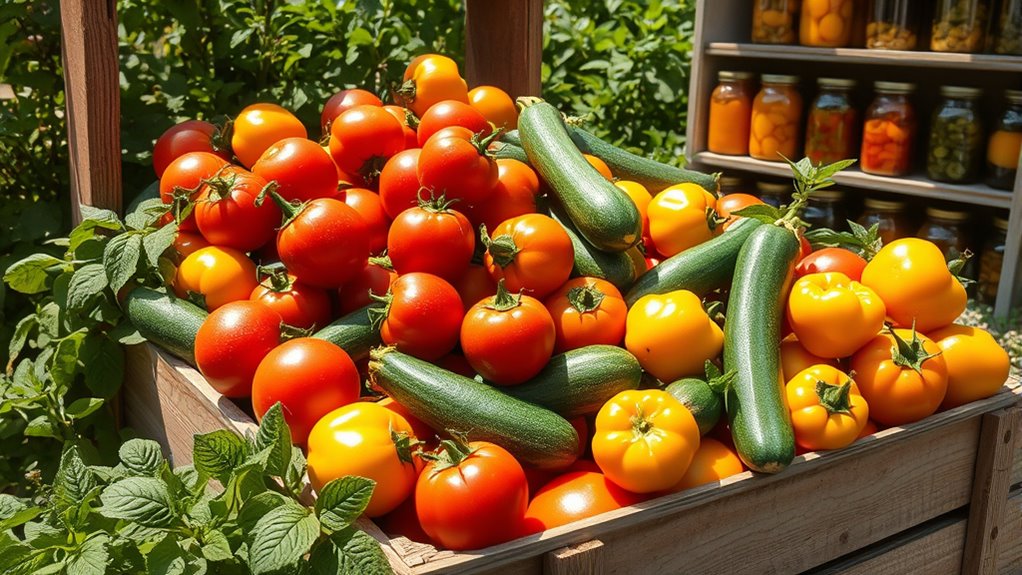
To enjoy the fruits of your labor long after the growing season ends, proper preservation and storage are essential. By mastering canning techniques, you can safely preserve your high-yield plants’ bounty, ensuring fresh flavors year-round. Seed saving allows you to plant your best performers next season, saving money and maintaining proven varieties. Store your preserved foods in cool, dark places to extend their shelf life. Label jars clearly and keep an organized record of your seed stock. For maximum freshness, consider freezing or dehydrating surplus produce. Proper techniques prevent spoilage and maintain quality. With these strategies, you’ll maximize your harvest and enjoy the rewards well into winter.
Proper preservation and storage ensure your harvest’s freshness and longevity through canning, seed saving, and ideal storage conditions.
- Canning techniques for long-lasting preservation
- Seed saving tips for future planting
- Proper storage conditions for produce
- Organizing your preserved foods and seeds
Frequently Asked Questions
Which Plants Are Best Suited for Container Gardening in July?
In July, you should focus on plants that thrive in containers, like tomatoes, peppers, and herbs. Companion planting helps improve growth and ward off pests, so consider pairing basil with tomatoes or marigolds with peppers. Practice crop rotation to prevent soil depletion and disease. Make certain your containers have good drainage and receive plenty of sunlight. These strategies will help you maximize your container garden’s productivity during this hot summer month.
How Can I Prevent Pests From Damaging High-Yield July Crops?
You might worry about pests ruining your crops, but organic pest control combined with companion planting can help you prevent damage. Plant marigolds or basil near your high-yield July crops—they naturally repel pests. Regularly inspect your plants, remove affected foliage, and use organic sprays if needed. This proactive approach keeps pests at bay without harmful chemicals, ensuring a healthy, bountiful harvest all season long.
What Soil Amendments Boost July Plant Growth and Fruit Production?
To boost your July plant growth and fruit production, focus on soil amendments like compost application. It enriches the soil with essential nutrients and improves moisture retention. Additionally, use organic fertilizers such as composted manure or fish emulsion to provide a steady supply of nutrients. These amendments create a healthy environment for your plants, encouraging vigorous growth and abundant fruiting during the peak summer months.
Are There Specific Pruning Techniques to Improve July Harvests?
Oh, because pruning is just a casual chat, right? Wrong! To boost your July harvest, focus on proper pruning timing—trim early morning or late evening to reduce stress. Use sharp pruning tools to make clean cuts, encouraging healthy growth. Remove dead or overcrowded branches to increase airflow and sunlight. Remember, strategic pruning isn’t just for looks; it’s your secret weapon for a bountiful summer harvest.
How Do I Attract Pollinators to Enhance July Plant Yields?
To attract pollinators and boost your July yields, focus on planting flowering plants that attract bees and butterflies. Create bee-friendly habitats by providing native plants, nesting sites, and water sources. Avoid pesticides and choose diverse blooms that flower throughout the season. This will draw more pollinators, enhancing fruit set and vegetable production, leading to a more abundant July harvest. Your garden’s pollinator-friendly environment makes all the difference.
Conclusion
As July’s sun fuels your garden’s bounty, think of your plants as a vibrant symphony reaching its crescendo. With careful tending and thoughtful planning, your garden becomes a lush tapestry of colors and flavors. Keep nurturing each plant like a skilled artist, and you’ll harvest a cornucopia that overflows like a bountiful river. Embrace the heat, stay vigilant, and watch your summer garden flourish into a dazzling, edible masterpiece.

